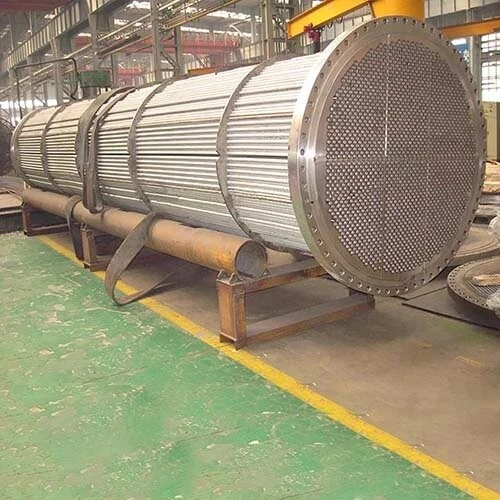Challenges in Heat Exchangers: Fouling and Corrosion Insights
Heat exchangers play a crucial role in the chemical industry, but issues like fouling and corrosion within these systems can result in compromised heat exchange efficiency, increased costs, and potential safety hazards. To address fouling and corrosion problems in heat exchangers, the following common causes are outlined for reference:

1. Fouling Issues in Heat Exchangers
2. Corrosion Challenges for Heat Exchangers
Corrosion presents significant challenges for heat exchangers, impacting their efficiency and longevity. The corrosion challenges can be categorized into several key types:
Metallic Corrosion: Plate corrosion, related to impure water, air-polluted water, inner pipe conditions, and fluid flow rate, constitutes metallic corrosion in heat exchangers.
Chemical Corrosion: Oxidation-reduction reactions occurring between metal and substances in contact with it contribute to chemical corrosion.
Galvanic Corrosion: An electrochemical process where metal corrodes in contact with an electrolyte solution, resulting in localized corrosion forms like stress corrosion cracking, pitting corrosion, and crevice corrosion.
Stress Corrosion: Requires specific corrosive conditions and sufficient tensile stress. Chloride ions play a crucial role, penetrating protective coatings, damaging passive films, and causing stress corrosion.
Biological Corrosion: Occurs when metal surfaces contact media like circulating water in water-cooling systems. Bionts consume corrosion inhibitors, metabolize acid, damage corrosion-resistant coatings, and disrupt oxygen density on metal surfaces.

1. Fouling Issues in Heat Exchangers
Fouling in heat exchangers poses significant challenges, affecting efficiency and performance. The fouling issues can be mainly classified into the following categories:
Particulate Fouling: Solid particles present in fluids, such as sands, dust, insoluble salts, and greasy dirt, can obstruct heat exchangers. Sediments produced by these particles may lead to under-deposit corrosion and provide a habitat for bacteria. Inadequate corrosion prevention can eventually result in corrosion perforation and leakage.
Biofouling: In circulating water systems, microorganism fouling, including iron bacteria, fungi, and algae, can occur. Iron bacteria can induce concentration cell corrosion, while algae can cause under-deposit corrosion and pipeline clogging, reducing fluid flow and heat exchange efficiency.
Crystal Fouling: As water evaporates in circulating water systems, soluble salts can precipitate on the heat-transfer surface, forming inorganic salt deposits known as crystal fouling.
Corrosion Fouling: Corrosive fluids or impurities in fluids can corrode heat exchanger surfaces, leading to precipitation. The degree of corrosion depends on fluid components, temperature, and pH. Copper pipes and brass tubes may react with oxygen, producing corrosion products.
Freezing Fouling: Fluids solidifying on the heat-transfer surface, such as water turning into ice, can lead to freezing fouling, depending on temperature uniformity.
Biofouling: In circulating water systems, microorganism fouling, including iron bacteria, fungi, and algae, can occur. Iron bacteria can induce concentration cell corrosion, while algae can cause under-deposit corrosion and pipeline clogging, reducing fluid flow and heat exchange efficiency.
Crystal Fouling: As water evaporates in circulating water systems, soluble salts can precipitate on the heat-transfer surface, forming inorganic salt deposits known as crystal fouling.
Corrosion Fouling: Corrosive fluids or impurities in fluids can corrode heat exchanger surfaces, leading to precipitation. The degree of corrosion depends on fluid components, temperature, and pH. Copper pipes and brass tubes may react with oxygen, producing corrosion products.
Freezing Fouling: Fluids solidifying on the heat-transfer surface, such as water turning into ice, can lead to freezing fouling, depending on temperature uniformity.
2. Corrosion Challenges for Heat Exchangers
Corrosion presents significant challenges for heat exchangers, impacting their efficiency and longevity. The corrosion challenges can be categorized into several key types:
Metallic Corrosion: Plate corrosion, related to impure water, air-polluted water, inner pipe conditions, and fluid flow rate, constitutes metallic corrosion in heat exchangers.
Chemical Corrosion: Oxidation-reduction reactions occurring between metal and substances in contact with it contribute to chemical corrosion.
Galvanic Corrosion: An electrochemical process where metal corrodes in contact with an electrolyte solution, resulting in localized corrosion forms like stress corrosion cracking, pitting corrosion, and crevice corrosion.
Stress Corrosion: Requires specific corrosive conditions and sufficient tensile stress. Chloride ions play a crucial role, penetrating protective coatings, damaging passive films, and causing stress corrosion.
Biological Corrosion: Occurs when metal surfaces contact media like circulating water in water-cooling systems. Bionts consume corrosion inhibitors, metabolize acid, damage corrosion-resistant coatings, and disrupt oxygen density on metal surfaces.

